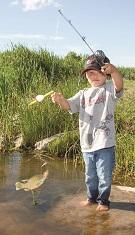
Each year, fishing draws millions of new recreational participants, generating an enormous amount of income for destinations with desirable angling. Beyond the recreational perspective, fishing is at the center of beloved events, both large and small, that become integral parts of the communities that host them. But even for a sport with such a strong following, continued growth requires well-planned events, strong leadership and sound strategy. Fortunately, that’s exactly what fishing has.
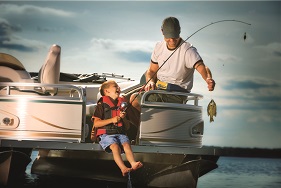
“It should be obvious that our country is becoming more diverse, but when you look at our sport, you don’t see diversity,” says Frank Peterson, president and CEO of the Recreational Boating and Fishing Foundation (RBFF). “One of our charges is to bring new people into the sport.”
To that end, the RBFF launched an initiative this April to engage America’s Hispanic population in fishing. The program will begin in Florida and Texas, in partnership with the Florida Fish & Wildlife Conservation Commission and the Texas Parks & Wildlife Department. The states will serve as test markets for five-year Hispanic Outreach Plan that will include a fully integrated marketing plan, using digital, social and traditional media.
“This is the fastest growing audience in America, and our campaign hopes to make fishing more relevant to that audience,” says Peterson. “Our research told us that the conservation angle—participating in a sport that helps protect the water, environment and fish—is very important to the Hispanic audience.”
First, however, a number of misconceptions had to be corrected. Many Hispanics, they learned, didn’t know that the dollars generated from fishing licenses fund conservation. As a result, many Hispanic anglers were not buying licenses.
But that’s not the only catch the RBFF is after. “We’ve also made strides with getting more women to participate,” says Peterson. “About 25 percent of all fishermen are now women.”
Youth are also on the line. The organization’s “Take Me Fishing” campaign has created an exclusive partnership with Walt Disney World Resort and Disney Media Networks, encouraging visitors who boat and fish at Walt Disney World Resort to take their newfound love for fishing home with TakeMeFishing.org, the RBFF’s site that provides local boating and fishing information.
“Fishing is a good way to connect with your family and kids. You get to escape together,” says Peterson. “It’s also a cost effective sport for families, costing around $115 for a family of four to engage in fishing versus, say, $500 a year to go to a water park.”
The Challenges of the Insatiable Fishing Market
From the first fishing show in the early ‘50s to a world where there aren’t just fishing shows, but entire fishing networks, the market for fishing has exhibited nothing if not infinite potential for growth.
“One of our biggest challenges is the acquisition and consumption of content. We have a passionate audience of fans that are hungry for knowledge and the best professional anglers in the world for them to learn from,” says Angie Thompson, vice president, events and sponsorship activation, B.A.S.S. “As much content as we produce (and we produce a LOT) is gobbled up by the fans and they are eager for more.”
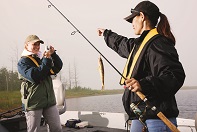 Attendance is tied to that content, says Thompson. B.A.S.S., creator of not just some of America’s largest and most popular fishing events, but also a media powerhouse at the sport’s center, has noted a sharp increase in attendance (43% in 2013) which B.A.S.S. credits to its online content motivating fans to see the event in person.
Attendance is tied to that content, says Thompson. B.A.S.S., creator of not just some of America’s largest and most popular fishing events, but also a media powerhouse at the sport’s center, has noted a sharp increase in attendance (43% in 2013) which B.A.S.S. credits to its online content motivating fans to see the event in person.
They also give credit to one more thing: “Sharp local host partners,” says Thompson, “who know how to leverage our brand to draw that heartland consumer out to the big show.
Another challenge, is on-water Internet access, preventing organizers from delivering live feed at the most critical competition moments, says Thompson. “We are constantly looking to change that and we hope that in the near future we will have partners in our destinations that work alongside us to find solutions for that.”
Noting a major growth trend in college and high school aged anglers, BA.S.S. now has over 300 teams in five conferences and sends a college angler to the Bassmaster Classic, the world championship of bass fishing. The organization also organizes the Carhartt College Bass Series on ESPNU and aims, next year, to have all of its events on a college campus.
“Imagine the impact on recruiting that this could have for some smaller schools near great bodies of water that could attract students simply because of that proximity,” says Thompson.
The same could be said for any destination that happens to be located near an exceptional body of water, as America’s destinations prove time and again.
When it comes to successful fishing events, a number of destination strategies and characteristics are key. No matter what the catch or the location, however, one crucial quality is a constant: “When everyone works together to achieve a shared goal, as these organizations do, the results are spectacular,” says Kathy Fennel, president of the Operations Division for FLW, the world’s largest tournament-fishing organization, offering millions of prize dollars to bass and walleye anglers across America each year.
A Fervent Fishing Culture
Fishing tournaments begin early and stretch out into long days on the water, but many of the most popular ones end with a festive weigh-in, and that means that you can increase angler appeal if your event is likely to draw a crowd. One way to ensure a crowd is to locate your event in an established and passionate fishing community. Ocean City, Maryland, a classic East Coast coastal destination, is just such a place.
“Being a coastal community, we have so many opportunities for fishing events, both offshore and from our beach, and recreational fishing is very popular,” says Donna Abbott, director, Ocean City Department of Tourism.
Ocean City’s large and long-successful tournaments are proof: the Ocean City Tuna Tournament, drawing boats from across the world, celebrates 27 years in July; and the White Marlin Open, at 41 years old, is the world’s largest billfish tournament.
But in Ocean City, you can count on more than good fishing. Good attendance is also standard.
“The thing about Ocean City is, even if you don’t fish or participate, everyone goes to the Harbour Island Marina for the weigh-ins,” says Abbott. “It’s really exciting each night to see these boats come in with these huge fish.”
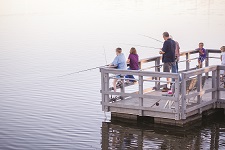
Location, as always, is key, and Lake Lanier, in Gainesville, Georgia, is a prime example.
“Lake Lanier is unique in that it is situated in the heart of bass fishing country, within a comfortable eight-hour drive of six of [FLW’s] top seven membership markets,” says Fennel. “This fact coupled with the Gwinnett Center and arena that seem built to host the Forrest Wood Cup and the incredible mega ramp at Laurel Park, both staffed with personnel that are second to none, make Lake Lanier an ideal host site.”
Host of two of the most successful Forrest Wood Cups of all time, Lake Lanier drew 50,000 spectators for the 2010 Cup and 60,000 spectators for the event in 2012. An avid local fishing culture is certainly a chief driver in that turnout, but partnership was also crucial.
“The final factor in making these events a success for all stakeholders are the great relationships we have with the State of Georgia, Gwinnett Convention and Visitors Bureau, Lake Lanier Convention and Visitors Bureau, and Georgia Department of Natural Resources,” says Fennel.
A unique catch
One aspect that gives a destination appeal for fishing tournaments: offer an unusual catch. Gillette, Wyoming, has an advantage in that arena, with its Keyhole Reservoir, offering not just 53 miles of shoreline and over 9,000 surface acres, but also the only body of water in Wyoming where it is possible to fish for northern pike.
Drawing a crowd is easy in Gillette, where the angling population extends all the way to its youngest population.
“The Gillette Fishing Lake at Dalbey Park, two miles south of downtown, is a very popular place to fish. It’s heavily stocked, so it’s especially great for kids learning to fish,” says Mary Silvernell, executive director, Campbell County Convention and Visitors Bureau.
Reel Them in with Natural Beauty
Ask any angler, and you’ll hear that one of the main reasons they like to fish is the beauty of their surroundings. Very few destinations can offer a more iconic, therefore wildly appealing, setting.
“Fishing is so special and popular here because our three rivers provide the ideal habitat for stone flies, the main feeding source for wild trout,” says Mary Holmes, destination marketing sales manager, Destination Missoula. “Our preserved rivers are not stocked. The fish are wild and natural, which is not common in other cities.”
Missoula is, in fact, a bucket-list destination for many anglers, seeing an approximately 25 percent increase in outfitter trips over the last two years. One possible reason: Missoula is also one of the filming sites for the classic fly fishing film, “A River Runs Through It.” Fortunately, Missoula also offers a long season; fishing runs strong March through October thanks to the wild habitat that feeds trout throughout that season.
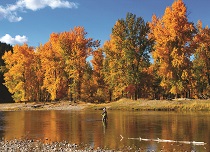
Sometimes what you need to kick off a successful event is a community that knows how to celebrate. For that, check out Annapolis and its neighbor Eastport.
“If you’re looking for a community that supports fun, this is it,” says Susan Steckman, vice president of communications, Annapolis and Anne Arundel County Conference and Visitors Bureau.
Annapolis is also home to the Boatyard Bar and Grill Opening Day Rockfish Tournament, celebrating its 13th year in 2014. It’s also one of the first tournaments to make use of the digital age for scoring.
“I always wanted to do it opening day,” says Dick Franyo, organizer and owner of the Boatyard Bar and Grill. “It’s the first real day of spring, the day everyone celebrates. But you can’t hold a kill fish tournament until May because the fish are spawning before then. So a friend of mine, Joe Evans, who used to run Prop Talk Chesapeake Magazine, said, ‘No problem. Everyone’s got a digital camera these days.”
Each year, organizers give colored yard sticks to the participating anglers (a new color every year). They catch a fish, snap a photo of it next to the yard stick, and submit their photos for judging. The Boatyard bar and Grill Opening Day tournament led the way in catch-and-release tournaments, and today even offer a cash prize. The real prize is notoriety: the winners get the outline of their fish painted on the Boatyard ceiling.
Share Your Way to Success
As fishing popularity increases, so does competition for participation and attendance. If you’re planning a new tournament, consider taking a page from the B.A.S.S. playbook and create a way for your anglers to interact.
“Our audience is a participatory demographic and as they participate in the sport they want to share their experiences. So we see a lot of photos being shared in the digital space and consumer generated video is moving fast through this market,” says Thompson. “We celebrate this because it helps more people become interested in trying the sport for themselves and subsequently we hope it gives them a healthy respect for the sport and the resources. There’s not much more all-American than a day on the lake, so seeing this content bubble up in different places is gratifying.”
After all, everyone loves a good fisherman’s tale.

